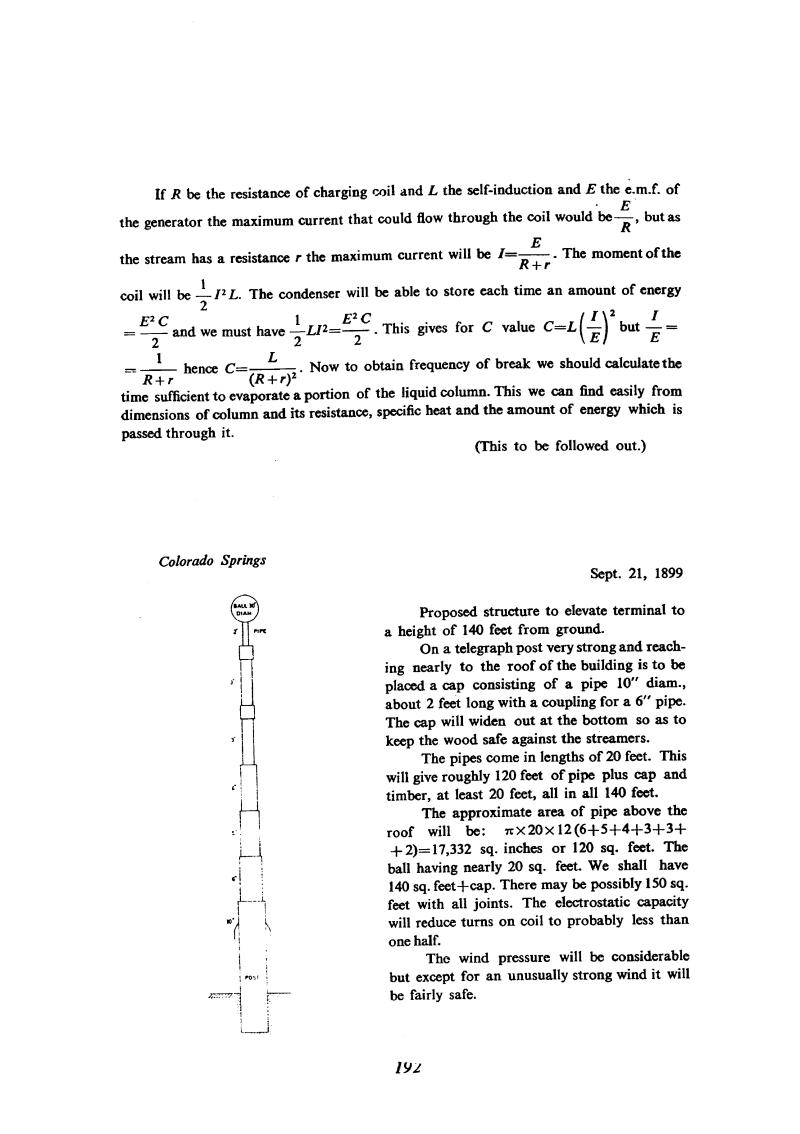
Nikola Tesla Books
If R be the resistance of charging coil and L the self-induction and E the e.m.f. of the generator the maximum current that could flow through the coil would be $! {E \over R} $!, but as the stream has a resistance r the maximum current will be $! {I = {E \over R + r}} $!. The moment of the coil will be $! {{1 \over 2}I^{2} L} $!. The condenser will be able to store each time an amount of energy $! {= {{E^{2} C} \over 2}} $! and we must have $! {{1 \over 2}LI^{2} = {{E^{2} C} \over 2}} $!. This gives for C value $! {C = L \left({I \over E}\right)^{2}} $! but $! {{I \over E} == {1 \over {R+r}}} $! hence $! {C = {L \over {(R + r)^{2}}}} $!. Now to obtain frequency of break we should calculate the time sufficient to evaporate a portion of the liquid column. This we can find easily from dimensions of column and its resistance, specific heat and the amount of energy which is passed through it.
(This to be followed out.)
Colorado Springs
Sept. 21, 1899
Proposed structure to elevate terminal to a height of 140 feet from ground.
On a telegraph post very strong and reaching nearly to the roof of the building is to be placed a cap consisting of a pipe 10" diam., about 2 feet long with a coupling for a 6" pipe. The cap will widen out at the bottom so as to keep the wood safe against the streamers.
The pipes come in lengths of 20 feet. This will give roughly 120 feet of pipe plus cap and timber, at least 20 feet, all in all 140 feet.
The approximate area of pipe above the roof will be: Ï x 20 x 12(6 + 5 + 4 + 3 + 3 + 2) = 17,332 sq. inches or 120 sq. feet. The ball having nearly 20 sq. feet. We shall have 140 sq. feet + cap. There may be possibly 150 sq. feet with all joints. The electrostatic capacity will reduce turns on coil to probably less than one half.
The wind pressure will be considerable but except for an unusually strong wind it will be fairly safe.
192
September 20
He calculated the oscillator with electrolytic breaker and inductive coil in the supply line of the oscillator, assuming that the entire kinetic energy of the coil is converted into electrostatic capacitor energy, and that happens when the voltage in the capacitor reaches the source voltage. In the shown circuit, however, the voltage in the capacitor could reach even higher levels depending on the validity factor of the coil and the breaker speed, but Tesla does not consider such a case here. The breaker which Tesla describes here operates on the principle of a fine fluid stream evaporating under the influence of current through the device (please see pictures), and he studied it in relation to the oscillator design which he switches on by means of a disconnect.
September 21
He prepares the construction of the pole which carries at the top a metal sphere approximately 75 cm in diameter, total height of more than 42 meters. This is the aerial of the Tesla transmitter which is seen on the photographs of an outside view of the laboratory.


